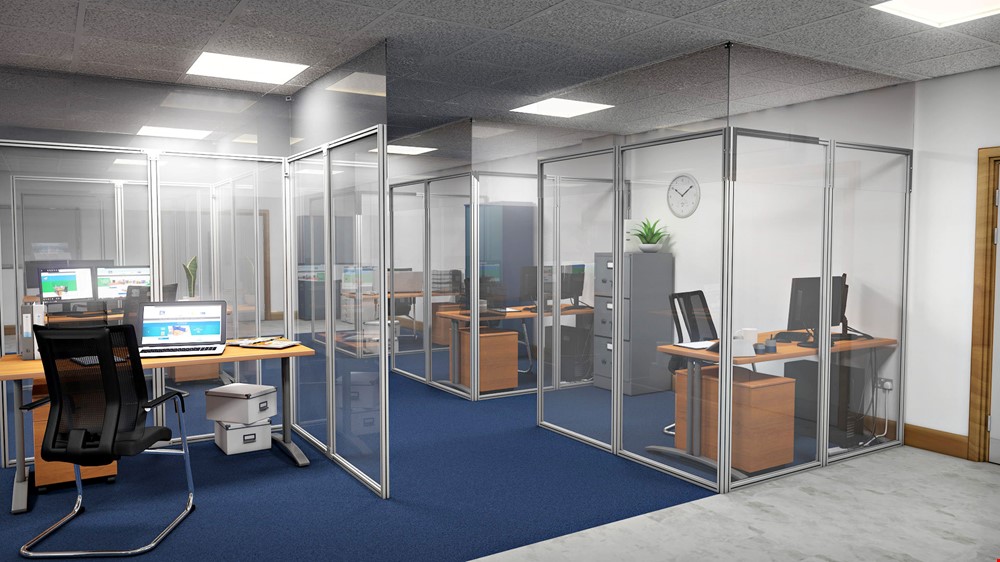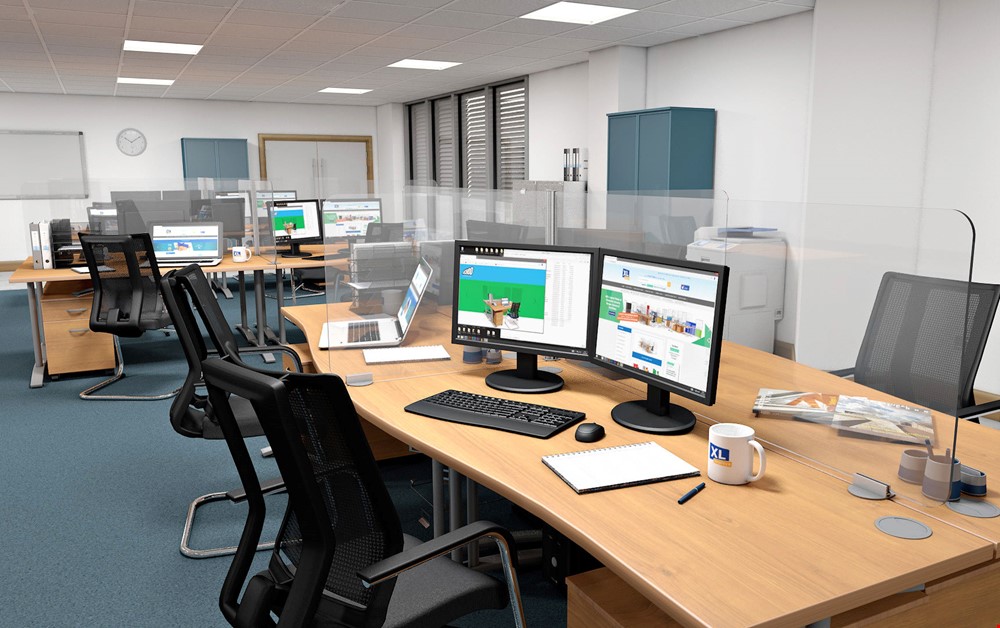It’s estimated that 86.5 million people worldwide have already had COVID-19, and with new variants of the virus appearing recently that are more transmissible, it’s likely that we will see that number rise significantly over the coming months in countries where significant restrictions are not already in place.
Here in the UK, as of January 6th, we enter into a third period of lockdown across the nation, which could last until spring. People have been advised to work from home wherever possible, however, for many industries and businesses, remote working is simply not feasible.
In offices up and down the country, these companies are grappling with how to set up a COVID-secure workplace for their employees, allowing them to work productively and collaboratively while obeying social distancing rules and keeping everyone as safe as possible.

But why are social distancing rules in place at all?
Social distancing was first introduced to us in the UK by the UK Health & Safety Executive (HSE) and the World Health Organisation (WHO) back in March 2020, when the first cases of Coronavirus were recorded in Great Britain. The basic rules require us to:
- Wear a face covering over our nose and mouth when in indoor public spaces such as supermarkets
- Remain 2m apart from those not in our ‘bubble’ at all times, indoors and outdoors
- Set up screens and dividers in offices, shops, hospitality venues and public spaces
For up-to-date details and information about all social distancing rules during this latest lockdown, visit the Gov.uk website.
The aim of lockdowns and social distancing measures is to slow the spread of Coronavirus in our communities and to bring the ‘R’ rate below 1, at which point the number of people suffering from COVID-19 will be falling rather than rising.
Coronavirus, like other infectious diseases such as flu, Norovirus or the common cold, is spread through three main forms of transmission:
- Contact/Droplet Transmission
Respiratory droplets, which are usually >5-10 μm in diameter, are expelled when an infected person sneezes, coughs, shouts or sings. These cannot travel far or ‘hang’ in the air for long, which is why keeping socially distanced from one another and using protective screens helps to prevent the transmission of the virus through this method.
- Airborne/Aerosol Transmission
Droplet nuclei or ‘aerosols’ are <5 µm in diameter and remain more active in the air, particularly in a non-ventilated room. Relatively little is known currently about how this affects the transmission of COVID-19, but studies are showing that the infection rate indoors can be minimised by all parties in the room wearing masks, the room being well ventilated, and reducing the number of time people spend together indoors.
- Fomite Transmission
Fomites are surfaces that have been contaminated with respiratory droplets from an infected person, which is why we are asked to sanitise our hands and our contact surfaces regularly. The WHO says that: ‘Despite consistent evidence as to SARS-CoV-2 contamination of surfaces and the survival of the virus on certain surfaces, there are as of yet no specific reports which have directly demonstrated fomite transmission.
In busy offices where collaborative working is essential, even during a lockdown phase, definite steps must be taken in order to set up a safe and hygienic working environment that combats all three kinds of virus transmission. Read on for our suggestions on how your workplace can still be a safe and productive environment, even during a pandemic.
Office Partitions And Screens

By far the best way to protect your staff during the pandemic is to install office partitions and dividers throughout your office space. Typically, office partitions are usually made from fabric-covered wooden panel screens but more recently, with the COVID-19 pandemic there has been a sharp increase in the demand for Perspex® acrylic or glass screens. The Perspex® surface makes them easy to wipe down and sanitise regularly to maintain a hygienic working environment. They are available in a wide variety of shapes and sizes to suit individual needs – but if you don’t see quite what you need on our site, our expert team can help you design a bespoke solution for your business.
To divide larger, open-plan offices into smaller meeting rooms or ‘team’ spaces, floor-to-ceiling screens are an excellent way to ensure complete separation. These specially designed ‘cubicles’ are adjustable up to 2.6m high to fit flush to your office ceiling. Use them to create individual meeting rooms or team spaces for smaller groups of employees.
Installing desk divider screens is a great way to make large banks of desks safer and more hygienic places for people to work. As acrylic is transparent, these screens allow collaborative working to continue while preventing the transfer of respiratory droplets from person-to-person, by forming a physical barrier between employees. By using desk partitions, you can even set up meeting rooms as safe spaces for collaborative work.
Investing in mobile screens is a great way to provide protection that’s flexible and adjustable. Our mobile dividers have lockable castor wheels fixed to the base, meaning that you can roll them easily around your office and lock them in place in any desired location.
Freestanding linked screens allow you to segment a larger office floor or retail space into smaller areas, keeping teams separate for a safer and more hygienic environment. Our freestanding screens have stable bases and come with linking strips included, so you can join several of them together to form temporary ‘walls’ and meeting rooms, as you require.
For a quick and easy solution that can be rolled up and down whenever you require it, a low-cost option for individual social distancing screens is retractable sneeze guards. Manufactured from 300μm Thick Transparent Plastic and adjustable in height, these handy screens are ideal for fluid environments where contact is infrequent. They are lightweight and easily portable and can be carried around the office and set up wherever you need them. Simply roll them up and fix them in place for an instant protective barrier. They’re also available in full-height protective barriers.
Of course, these are just a few of the many different social distancing screen options available on our site – why not browse our full collection of office screens to find the ones that best suit your business needs?
Floor Markings & Face Masks
Restaurant policies (pre-lockdown) mandated that diners had to wear ‘appropriate face coverings’ at any time inside the building that they were not seated. This meant that the thoroughfares and spaces such as entryways, corridors and toilets were kept safer as masks are designed to catch the majority of respiratory droplets we breathe out through our mouth or nose. Encouraging this system in office buildings (wear a mask unless seated at your desk) will help to slow any virus transmission if one member of staff becomes infected.
Floor markings are also an essential tool for larger offices, factories, shop floors and other work environments that remain open during the lockdown. By creating one-way traffic flow systems, you can ensure employees can remain safely 2m apart while moving around the building.
Ventilation
Studies have shown that well-ventilated indoor areas can help to prevent aerosol transmission of the virus. While larger respiratory droplets fall quickly out of the air, aerosols can remain airborne for some time and distance, meaning that poorly ventilated indoor spaces where one person is COVID-positive can quickly become hotbeds of infection. HSE recommends opening windows – but in spaces with no functioning vents or windows, installing air conditioning or air circulation systems, fans or air filtration units can help protect employees.
Staff Rotation
Wherever possible, dividing your workforce into smaller teams and staggering who is present in the office at any one time can reduce the rate of transmission within your business if one person contracts Coronavirus. Smaller groups allow you to make the most of your social distancing screen set-up, as fewer dividers are needed to keep sparser teams safe. This gives you additional value for your social distancing partition investment, as one set-up can be sanitised at the end of every day before a new ‘team’ arrives to make use of the space.
Even during the COVID-19 challenge, it is possible to provide your employees with a work environment that’s as safe and secure as you can possibly make it. These are unprecedented times, and we must all adapt to the changing situation. But the show must go on – and setting up a safe and collaborative workspace is the best way to ensure your business remains productive and profitable during the pandemic.
For more advice on setting up your office with adequate social distancing measures, our expert team will be more than happy to help. Give them a call on 01733 511030, or send your office layout through to them via our Contact Us page for a personalised solution.
Permalink:
https://www.xldisplays.co.uk/news/how-to-create-a-safe-and-collaborative-workplace-using-office-partitions.aspx